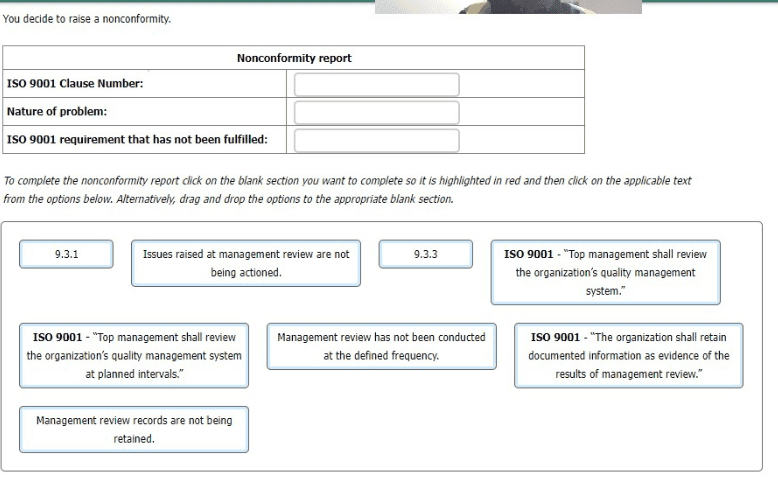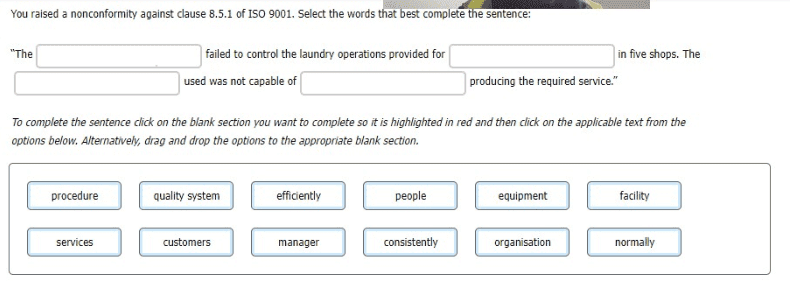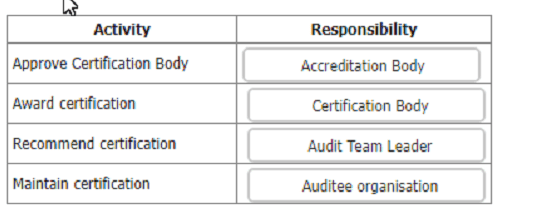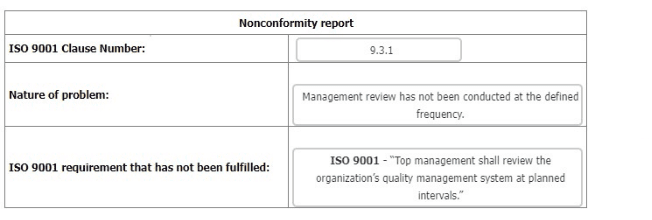PECB ISO-9001-Lead-Auditor - QMS ISO 9001:2015 Lead Auditor Exam
For a third-party, match the Activity with the Responsibility for conducting it.

During the opening meeting of a third-party audit of a pharmaceutical organisation (CD9000) with seven COVID-19 testing laboratories in various terminals at a major international airport, you are asked if you could
visit all laboratories. As audit team leader you say that, based on sampling criteria, you had planned to audit only three of them as CD9000 is a multisite organisation.
They tell you that they have worked so hard to get ready for the audit that the supervisors of those laboratories that would not be visited would be quite disappointed.
The following are possible responses to the request, select the two best responses:
Scenario 3:
Fin-Pro is a financial institution in Austria offering commercial banking, wealth management, and investment services. The company faced a significant loss of customers due to failing to improve service quality as they expanded.
To regain customer confidence, top management implemented a QMS based on ISO 9001. After a year, they contacted ACB, a local certification body, to pursue ISO 9001 certification.
The audit team was led by Emilia, an experienced lead auditor, and included three auditors. After an agreement was reached, ACB sent the audit objectives to the audit team.
The audit team began by gathering information about Fin-Pro’s understanding of ISO 9001 requirements. While reviewing documented information, they noticed missing records of training and awareness sessions. They conducted employee interviews to verify attendance.
The team also reviewed the organizational chart and job descriptions to confirm employee competence. They observed the company’s working environment (social, psychological, and physical conditions).
The audit team analyzed the evidence and prepared an audit report with findings and conclusions.
What type of evidence has been collected by the ACB’s audit team, as presented in scenario 3?
Which quality management principle does an organization fulfill when it assesses risks, consequences, and impacts before taking action?
You are carrying out an annual audit at an organisation that offers home security services. You are interviewing the Quality Manager (QM)
You: "Would you tell me about your management review process?"
QM: "The senior management team plans to review the management system every six months. The review follows a set agenda and records are maintained."
You: "May I see the records from the last two management reviews?"
Narrative: The Quality Manager gives you the latest record, which shows the last management review took place nine months ago.
The Quality Manager then gives you the previous management review record, which took place one year before the latest review.
You: "Are there any other review reports in the last two years?
QM: "No, these are the only ones."

Whistlekleen is a national dry cleaning and laundry company with 50 shops. You are conducting a surveillance audit of the Head Office and are sampling customer
complaints. You find that 80% of complaints originate from five shops in the same region. Most of these complaints relate to damage to customer laundry. The Quality
Manager tells you that these are the oldest shops in the company. The cleaning equipment needs replacing but the company cannot afford it at the moment. You learn
that the shop managers were told to dismiss most of the claims on the basis of the poor quality of the laundered materials.
On raising the matter with senior management, you are told that there are plans to replace the equipment in these shops over the next five years.

During an ISO 9001 audit of an electric cable manufacturer, you are reviewing the customer file for XYZ Construction in the Sales Department. This contract specifies that the installation configuration of the cable runs should meet national fire safety standards for Category A.
You discover that the customer later agreed to the approval of a less stringent Category B configuration instead.
The organization has the following quality policy document displayed in the reception area.
"This organization is committed to providing electric cables to customers' requirements, in accordance with statutory regulations for their use. Continual improvement is a permanent objective of the organization. This policy shall be communicated to all employees and, where required, to all interested parties."
Referring to the scenario, select the two options for which the organization is meeting its policy commitments.
Which type of audit risk is the risk that a significant defect may occur in the QMS, although the organization has internal control mechanisms in place?
"A set of interrelated or interlacing elements of an organization to establish policies and objectives, and processes to achieve those objectives" is the definition of a/an:
You are an auditor from a construction organisation who is conducting a second party audit to ISO 9001 at a steel rolling mill producing
structural steelwork. When auditing the rolling process, you find that the operator who is unloading the furnace does not use the
adjacent infrared pyrometer to measure the appropriate product temperature in readiness for the next production stage.
You: "How do you tell when the billet is ready for the rolling stage?"
Operator: "I've done this job for 20 years. I can tell by the bright red colour."
You: "What happens if the colour is wrong?"
Operator: "The billet goes back into the furnace."
You: "Is the pyrometer ever used?"
Operator: "Only in borderline cases."
You continue to interview the operator and find that around 25% of the billets are sent back to the furnace. This includes 80% of the borderline cases.
Select three options that would provide evidence of conformance with clause 9.1.1 of ISO 9001.








